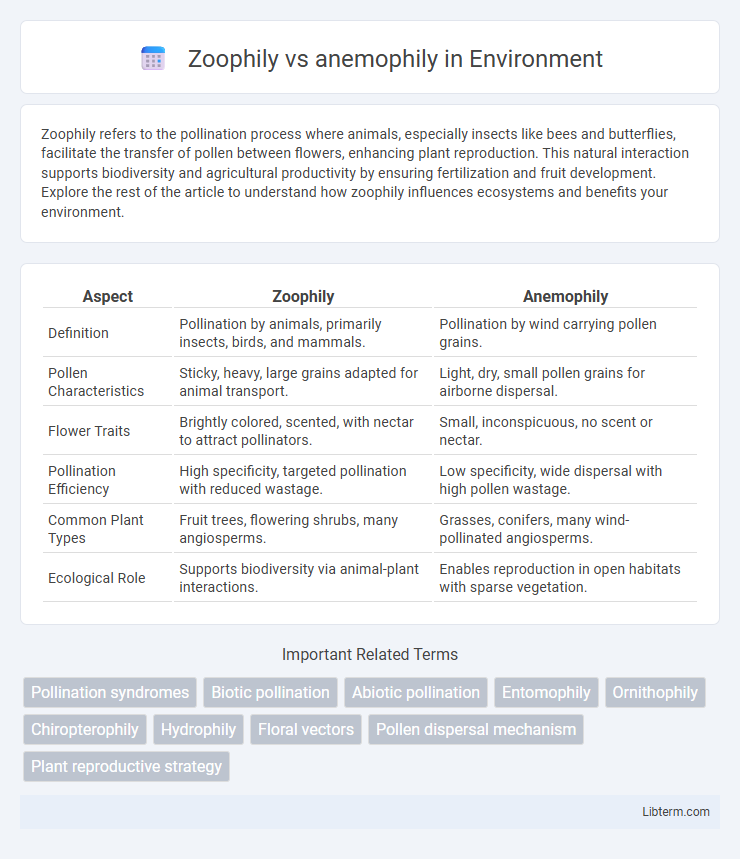Zoophily refers to the pollination process where animals, especially insects like bees and butterflies, facilitate the transfer of pollen between flowers, enhancing plant reproduction. This natural interaction supports biodiversity and agricultural productivity by ensuring fertilization and fruit development. Explore the rest of the article to understand how zoophily influences ecosystems and benefits your environment.
Table of Comparison
| Aspect | Zoophily | Anemophily |
|---|---|---|
| Definition | Pollination by animals, primarily insects, birds, and mammals. | Pollination by wind carrying pollen grains. |
| Pollen Characteristics | Sticky, heavy, large grains adapted for animal transport. | Light, dry, small pollen grains for airborne dispersal. |
| Flower Traits | Brightly colored, scented, with nectar to attract pollinators. | Small, inconspicuous, no scent or nectar. |
| Pollination Efficiency | High specificity, targeted pollination with reduced wastage. | Low specificity, wide dispersal with high pollen wastage. |
| Common Plant Types | Fruit trees, flowering shrubs, many angiosperms. | Grasses, conifers, many wind-pollinated angiosperms. |
| Ecological Role | Supports biodiversity via animal-plant interactions. | Enables reproduction in open habitats with sparse vegetation. |
Introduction to Plant Pollination
Plant pollination involves the transfer of pollen from the male anthers to the female stigma, essential for fertilization and seed production. Zoophily refers to pollination facilitated by animals such as bees, butterflies, birds, and bats, which actively transport pollen while seeking nectar or pollen. Anemophily, or wind pollination, relies on the passive movement of lightweight, abundant pollen grains carried by air currents to reach female reproductive organs.
Understanding Zoophily: Animal-Mediated Pollination
Zoophily refers to pollination facilitated by animals such as bees, butterflies, birds, and bats, which transfer pollen while feeding on nectar or pollen. This mutualistic relationship enhances genetic diversity and reproductive success in flowering plants by ensuring targeted pollen dispersal to conspecific stigmas. Unlike anemophily, which relies on wind for pollen distribution, zoophily often results in higher pollination efficiency due to animal behavior and floral adaptations like bright colors and scents.
Exploring Anemophily: Wind-Driven Pollination
Anemophily is a pollination strategy where wind serves as the primary agent for pollen transfer, enabling plants like grasses, conifers, and many deciduous trees to reproduce effectively without animal involvement. This method hinges on producing copious amounts of lightweight, aerodynamic pollen grains that can travel long distances to reach female reproductive structures. In contrast to zoophily, which relies on attraction mechanisms such as nectar and bright petals to lure animals, anemophilous plants often exhibit reduced floral structures and lack scent, emphasizing adaptation to wind dispersion for reproductive success.
Key Differences Between Zoophily and Anemophily
Zoophily involves pollination by animals such as insects, birds, or mammals, whereas anemophily relies on wind for pollen dispersal. Zoophilous flowers often have bright colors, nectar, and scent to attract pollinators, while anemophilous flowers tend to be small, inconspicuous, and produce large amounts of lightweight pollen. Zoophily typically results in targeted pollen transfer, increasing fertilization efficiency, in contrast to the random and less efficient pollen distribution seen in anemophily.
Adaptations of Zoophilous Plants
Zoophilous plants exhibit specialized adaptations such as brightly colored petals, strong fragrances, and nectar production to attract specific animal pollinators like bees, birds, and bats. These plants often have structural modifications including tubular flowers, sturdy stamens, and sticky pollen to facilitate effective pollen transfer by animals. These traits enhance reproductive success by ensuring targeted pollination and minimizing pollen waste compared to anemophilous plants, which rely on wind dispersal without such specialized features.
Features of Anemophilous Plants
Anemophilous plants are characterized by lightweight, abundant pollen grains adapted for wind dispersal, featuring small, inconspicuous flowers that lack nectar and strong scents. Their stamens and stigmas are often exposed and feathery to maximize pollen capture and release efficiency in air currents. These plants typically produce large amounts of pollen to increase the chances of successful fertilization despite the randomness of wind pollination.
Ecological Significance of Zoophily
Zoophily, or animal-mediated pollination, plays a critical role in maintaining biodiversity and ecosystem stability by enabling the reproduction of a wide variety of flowering plants. This mutualistic interaction supports pollinator populations such as bees, butterflies, birds, and bats, which in turn promotes genetic diversity and plant resilience against environmental stressors. In contrast to anemophily, or wind pollination, zoophily enhances precision and efficiency in pollen transfer, reducing pollen waste and increasing reproductive success in diverse habitats.
Environmental Impact of Anemophily
Anemophily, or wind pollination, significantly influences ecosystem dynamics by contributing to the dispersal of pollen over large areas, which can enhance genetic diversity among plant populations. Unlike zoophily, which depends on animal pollinators and can be affected by pollinator decline, anemophily is less vulnerable to such ecological disturbances but often leads to increased pollen production, potentially exacerbating air pollution and allergen prevalence. The environmental impact of anemophily also includes the promotion of specific plant communities adapted to open, windy habitats, affecting biodiversity and ecosystem structure.
Examples of Zoophilous and Anemophilous Species
Zoophily involves pollination by animals such as bees, birds, and bats, with examples including honeybees pollinating clover and hummingbirds visiting trumpet flowers. Anemophily refers to wind pollination, commonly seen in grasses like maize and trees such as pines, where pollen is dispersed through air currents. These distinct pollination strategies reflect adaptations to specific ecological niches and reproductive needs.
Conclusion: The Importance of Pollination Mechanisms
Pollination mechanisms such as zoophily and anemophily are vital for the reproduction and genetic diversity of many plant species. Zoophily, involving animals like bees, birds, and bats, ensures targeted pollen transfer, enhancing cross-pollination efficiency. Anemophily relies on wind, supporting plant species adapted to open habitats and promoting widespread pollen dispersal, highlighting the ecological importance of both mechanisms in sustaining biodiversity.
Zoophily Infographic

 libterm.com
libterm.com